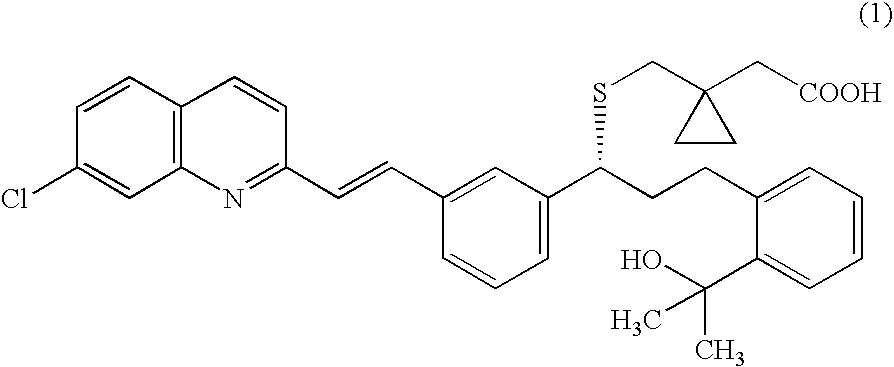Process for making montelukast and intermediates therefor
a technology of montelukast and intermediates, which is applied in the direction of drug compositions, immunological disorders, organic chemistry, etc., can solve the problems of not being able to provide the compound (2) stereoselectively, and not being able to obtain the racemic produ
- Summary
- Abstract
- Description
- Claims
- Application Information
AI Technical Summary
Benefits of technology
Problems solved by technology
Method used
Image
Examples
example 1
Compound (11)
[0066]Step 1—Compound (20)
[0067]500 g of Methyl 2-((3S)-3-[2-(7-chloro-2-quinolinyl)-ethenyl]-phenyl)-3-hydroxypropyl)-benzoate monohydrate [Compound (18)] were placed into reactor and 3000 ml of toluene were added. The mixture of toluene / water was azeotropically distilled off (800 ml). Then the toluene solution was cooled to room temperature. The solution contained 480.11 g of anhydrous (18).
[0068]To the solution, 227.0 ml of triethylamine were added at room temperature and 110.2 ml of methanesulfonyl chloride were added dropwise so that reaction temperature did not exceed 40° C. Reaction mixture was subsequently stirred at 25-30° C. for 1 hour. Then 605 ml of triethylamine were added to the reaction mixture followed by addition of 156 ml of thioacetic acid at room temperature within 5 minutes. The reaction mixture was subsequently heated to 40-45° C. for 3.5 hours. 1000 ml of water were added to the reaction mixture and it was stirred for 15 minutes. The layers were s...
example 2
Compound (11)
[0074]Work under argon.
[0075]24.50 g of compound (20) were dissolved in 180 ml of anhydrous toluene (distilled from benzophenone / Na). Solution was cooled to 0-5° C. (dry ice / water bath). 41 ml of 3M MeMgCl in THF were added dropwise to the solution so that temperature did not exceed 5° C. (over 30 minutes). Reaction mixture was stirred and cooled to 0-5° C. No precipitation observed. Reaction was monitored by HPLC. Reaction mixture is turning cloudy—slight precipitation. Reaction was stopped after 3 h and 100 ml of water were slowly added with external cooling. Reaction mixture was subsequently acidified with 3 ml of glacial acetic acid to pH=4-5. Layers were separated and organic extract was dried over anhydrous magnesium sulfate. Mixture was filtered and solvent was evaporated to dryness (bath heated to 45° C.) giving 20.05 g) of crude thiolactone (11) base.
[0076]HPLC—after evaporation—80.69%
example 3
Compound (11a)
[0077]2.586 g of thiolactone (11) were dissolved in 18 ml of toluene at 40° C. Solution was cooled to room temperature and 7.1 ml of 1M aqueous HCl were added with stirring. Mixture was stirred for 2 h at room temperature. Precipitated solid material was separated by suction and washed with 5 ml of toluene and dried at room temperature.
[0078]HPLC: 95.43%
[0079]Yield: 1.43 g (63%)
PUM
 Login to View More
Login to View More Abstract
Description
Claims
Application Information
 Login to View More
Login to View More - R&D
- Intellectual Property
- Life Sciences
- Materials
- Tech Scout
- Unparalleled Data Quality
- Higher Quality Content
- 60% Fewer Hallucinations
Browse by: Latest US Patents, China's latest patents, Technical Efficacy Thesaurus, Application Domain, Technology Topic, Popular Technical Reports.
© 2025 PatSnap. All rights reserved.Legal|Privacy policy|Modern Slavery Act Transparency Statement|Sitemap|About US| Contact US: help@patsnap.com



